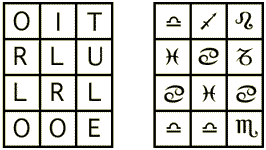The Cry of the 15th Aethyr
OXO[1]
TAN, TAN, TAN, TAN.[17]
Bou Sâada.
December 3, 1909. 9.15 - 11.10 a.m.
[1] OXO = Libra, Spirit, Libra. The Rose of Earth on the Place of Judgment; this is the scene of the Aethyr. לתל = 460 = קדש ליהוה, meaning "Holy unto the Lord", and refers to the consecration (after examination) of the Exempt Adept. It is his final preparation for undergoing in consciousness the full ceremony of passing to the grade of Magister Templi.
[2] This is a form of Babalon. There is a reference to the story of Salome in the lesser mysteries of the dagger and disk in the cult of "the God, John". "John" is "ON" — Oannes, Nu, Noah, Jonah, etc. — the Sun entering the watery sign of Cancer (the sign of the whale, ark, etc.) at the summer solstice.
[3] The colour of Venus, love. This is the basis of the act of worship.
[4] Sacred to the sphere of the stars, and to Malkuth, the sphere of Earth, respectively.
[5] The body of Nuit, the star-strewn Blue.
[6] The universal Mercury, instrument of the constant change and flux which constitutes life.
[7] That is, in the lowest grade of the Second Order of the R.R. et A.C., 5° = 6□, "God" is worshipped under the form of a man (Tiphareth). In 6° = 5□, he seems as a goat (Mendes Kahn). In 7° = 4□, a ram (Amoun). In 8° = 3□, a crab (connected with the star sponge vision). In 9° = 2□, an ibis (Thoth). In 10° = 1□ a golden hawk (Ra Hoor Khuit). Above this (Kether), He is the Negative only.
[8] This table is: 
[9] The Seven are the inferiors, unless the reference be to Babalon, as in the table of 49 squares. Twelve refers to HUA = הוא = 12 referred to Kether and in one of the invocations (as "The Angel who is set over these Mysteries") of the Golden Dawn and, of course, to the Zodiac The interweaving of multiplication is to the juxtaposition of addition as is chemical combination to mechanical mixture.
[10] See Kaballah Unveiled by McGregor Mathers, for 13 rivers of Holy Oil that flow down the Beard of Macroprosopus. (These are the first 13 letters.)
[11] See 22nd Aethyr for a fuller indication of this mystery, and infra.
[12] 5° = 6□
[13] This Adept guards Tiphareth and tests the heart (which pertains thereto) for its purity. (χαθαροσ = pure) six times; 6 being the number of Tiphareth.
[14] 6° = 5□.
[15] Similarly the right arm (of Geburah) five times. Fortis means strong.
[16] 7° = 4□.
[17] Similarly the left arm (of Chesed) four times, for the virtue of Chesed — Mercy. (See 17th Aethyr).
[18] 8° = 3□.
[19] The neck is of Daath (which is not a Sephirah, per se, and so has no number or corresponding symbol.)
[20] This part of the brain is of Binah (3). Samajh means understanding. That is, he admitted the right of the seer to the grade of Magister Templi, attributed to Binah, which means understanding.
[21] The seer was not worthy of the grade of Magus yet. Note that each adept uses a different language.
[22] All these practical mysteries must be worked out by the student himself. Any formula given by the annotator would probably be dead in the hands of another man.
[23] See Note 22.
[24] The easiest explanation of this is to suppose that the letters are not attributed as usual (i.e. I to Sagittarius, L to Cancer), but taken for their English shape (I the Middle Pillar, L the Square) — but this is far from satisfactory.
[25] Note that the corner letters in this table are all B = Leo. (These were the seven tablets or talismans used by Dee and Kelley in conjunction with the shew-stone.)
[26] This means there are different systems of physical motion for certain groups.
[27] Meaning Thoth. The attribution of the fixed stars to the Enochian alphabet has not been worked out. It pertains to the grade of Magus, and would have no interest or meaning for those of lower grades.
[28] Since the examination in the amphitheatre I have been a naked spirit without garments or anything; by garments he means the body.
[29] ABRAHADABRA spelt backwards, to reverse its formula, that of uniting the five with the six. See next paragraph.
[30] Because of saying ABRAHADABRA = 418, backwards. (For a more lengthy discussion of this word see the Qabalistic essay on Gematria in Equinox V, and in Sepher Sephiroth, Equinox VIII.